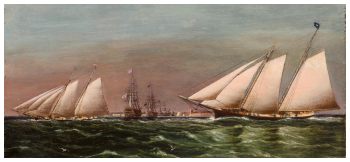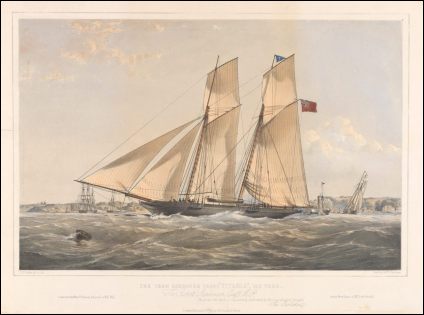Yves GARY Affichages : 2502
Catégorie : AMERICA
 From Hunt's universal yacht list for 1851
From Hunt's universal yacht list for 1851
The long-talked-of challenge given by the American Commodore Stevens, to sail any British yacht for any amount, having been accepted in the most friendly manner by G. R. Stephenson, Esq., the terms and conditions being left by both parties with the noble Commodore of the R.Y.S., the match was appointed to come off on Thursday, August 29, 1851, with the necessary "six-knot-breeze" for the purpose.
Great excitement has prevailed on the subject of the America, owing to the successful issue of her previous trials with our yachts. It was at one time thought that the match would have to be postponed, in consequence of the accident which happened to the America on the Tuesday night previous, she having taken the ground at the mouth of the harbor, and rubbed off about thirty feet of her false keel, which, however, was expeditiously replaced the next day in the Dockyard at Portsmouth, and the yacht, undocked the same evening, proceeded early the next morning to Cowes.
 The course appointed for this trial was, that they should proceed outside the island to a distance of twenty miles south-east of the Nab Light, where a station vessel was to be placed, and the yachts having rounded the same, were to make their way back to the Nab Light. Thus two points of sailing would be decided — outwards with the wind large, and a dead beat homewards.
The course appointed for this trial was, that they should proceed outside the island to a distance of twenty miles south-east of the Nab Light, where a station vessel was to be placed, and the yachts having rounded the same, were to make their way back to the Nab Light. Thus two points of sailing would be decided — outwards with the wind large, and a dead beat homewards.
The day opened with every appearance of a strong wind for the contest, and in the morning the yachts left Cowes for the rendezvous off the Nab, bearing W.S.W. from them, the Queen steamer, Captain D. Corke, having been expressly engaged to proceed out as the station vessel. At 9 o'clock the steamer left Cowes, having John Bates, Esq., the Squadron's secretary on board, and proceeded to the appointed place. The wind was strong from N.N.W. throughout the forenoon, and in the afternoon a fresh gale prevailed. A more fitting opportunity or better day could not have happened for so interesting a trial.
At 9h. 7m. with a strong wind, the Titania weighed from Cowes Roads and proceeded out to the east end. At 9h. 30m. the Titania hove to off the quarantine station, apparently waiting for her adversary, which, up to this period was observed at anchor in Cowes Roads. Some little anxiety was manifested about her, as there was no doubt that, owing to her having been undocked only the night before, some little preparation ere she could get ready to sail was necessary. At length she got under weigh and proceeded onwards to her station. At 10h. 14m. the Queen steamer took her departure from the Nab, bearing W.S.W. and steered S.E b.S., and having got about an hour's start in advance of the yachts, took a bearing at 11h. 15m. Owers light vessel b
 ore E.¼N., Yarborough Monument N.W.b.W., and Dunnose W.b.N.½N., which gave a distance of ten miles and a half. The course was altered to S.S.E., in consequence of the tide.
ore E.¼N., Yarborough Monument N.W.b.W., and Dunnose W.b.N.½N., which gave a distance of ten miles and a half. The course was altered to S.S.E., in consequence of the tide.
At this time the two schooners were observed under weigh steering in the direction of the steamer, and accompanied by the Xarifa, and four other yachts. At noon the Owers bore N.E., Culver Cliff N.W., and Dunnose about W.N.W.; an increasing breeze from N.b.W. with strong ebb tide, and the distance from Nab fourteen miles. In running towards the steamer the yachts were frequently observed to alter their positions. From hence the steamer steered S.E.b.S. until 12h. 46m., when the only bearing was Dunnose, which bore from her N.W. The Culver being out of sight, the steamer was judged to have reached the required distance, and she hove-to, and hoisted a blue ensign as the signal to round. America now bore from the steamer N.N.W. ten miles, the Titania in company. To all appearance they were following close upon each other, the America being the leading vessel. At 1h. 30m. the hull of the America was "fast rising," but the Titania's hull was invisible; in five minutes afterwards she was seen to jibe, but seemed to be "steering wild," the America being well handled, both being under a cloud of canvass, each having square sails, the Titania with topsail, but the America no gaff-top-sail, but apparently a watersail, which was now taken in. At 1h. 53m. Titania lowered her square topsail, and at 1h. 56m. the America hauled down her square-sail and prepared to round the steamer. The manner in which she came on, "as easy as a Limerick glove," was admired by all on board. The following is the order and time of rounding the steamer:

Thus there was a difference of 4m. 12sec. in favor of the "Yankee." As the America rounded, they stated that they had carried away the jaws of their main-gaff, but that they had secured it. Both yachts, after rounding the steamer, luffed up on the port tack, and reached in to the eastward of the Owers. There was now a fresh gale from the northward, and the steamer's head was turned in shore, the wind "dead on end," and plenty of it to test the relative merits of these vessels, the America being perfectly upright, and "slipping gracefully through it." On the contrary, the Titania "bowed," or rather "dipped her nose into it."
 We watched their progress minutely. The Titania wetted her sails, but all efforts even to recover her former position, appeared useless. The distance between the two yachts increased, and became visibly "more and more” as they progressed in shore.
We watched their progress minutely. The Titania wetted her sails, but all efforts even to recover her former position, appeared useless. The distance between the two yachts increased, and became visibly "more and more” as they progressed in shore.
At 3h. 30m. they tacked to the westward. The Culver Cliff bore N.W.½N. from the steamer; the America from the latter E.N.E., and the Titania S.E.b.E. At 3h 30m. the yachts had a strong wind to contend with, and both worked towards the Nab with the ebb in their favor. A better day — wind or tide— could not have been appointed.
The Titania was then observed with her topmast struck and under her three jibs, foresail and mainsail, the America with main sail, foresail, and fore-staysail, all without a reef in, and as “upright as a top." At 4h. 8m. Culvers, bearing N. W, ½W. America S.E., Titania S.E.b S., and four miles dead to leeward of her antagonist. The America tacked to the northward, Titania keeping her reach to the southward. At 4h. 30m. the America again tacked to the westward, and laid "well up” for the island. The Destiny and Dream were sighted outside, reaching in the East Channel. At 4h. 50m. the steamer returned to the Nab Light-vessel, and made fast to her, and remained to watch the motions of the vessels and note their return.
 The America reached in towards the island, distant from Nab two miles and a half, the Titania keeping her reach to the southward and westward, and was now "half mainsail down." At 5h. 30m. 15sec. the America having passed us, and brought the Nab to bear from her S.W., was timed as the winner. Unfortunately there was no gun on board to give either of the vessels a welcome, and a little smoke and steam from “the big tube" of the steamer was all that could be resorted to.
The America reached in towards the island, distant from Nab two miles and a half, the Titania keeping her reach to the southward and westward, and was now "half mainsail down." At 5h. 30m. 15sec. the America having passed us, and brought the Nab to bear from her S.W., was timed as the winner. Unfortunately there was no gun on board to give either of the vessels a welcome, and a little smoke and steam from “the big tube" of the steamer was all that could be resorted to.
The match was so far at an end, and the America stood on for Cowes, steering in for Brading, and then reached to the northward; from thence she again tacked, fetched in under Fishhouse, went about again, and after making another short tack, went to her moorings in Cowes Roads. At 5h. 57m. the Titania was seen making towards the steamer she having been nearly out of sight. After reaching in towards the island to the southward of the "Princessa," she tacked to the northward, and at 6h. 22m. 15sec. having reached the proper bearing, she was thus timed as arriving at the goal, being exactly 52m. behind the America out and home, which gives 4m. 12sec. in favor of the America for the run "dead before it," and 47m. 48sec. over her adversary in working back against a strong wind.
